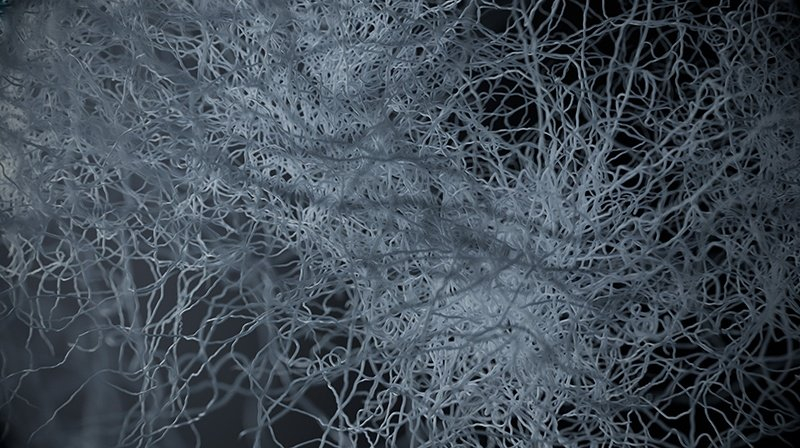
Exilva Microfibrillated Cellulose & Clay Platelets: anti-settling & anti-sedimentation because of yield stress
Ole Martin Kristiansen | July 9, 2019
Clay (including montmorillonite and bentonite) additives and Exilva microfibrillated cellulose (MFC) have a lot in common since they both can be used as rheology modifier in different industries. However, there are also clear differences. In this article, I will review the ability of the materials to provide yield stress and subsequent anti-settling & anti-sedimentation benefits. Tune-in on a comparison between two of the most potent anti-settling & anti-sedimentation additives available.
Clay products (including montmorillonite and bentonite) consist of solid particles that have a platelet shape. At low shear, the platelets form a house-of-cards structure that gives a three-dimensional network in a liquid.
Microfibrillated cellulose is a waterbased suspension consisting of long and thin cellulose fibers, called fibrils. At low shear, the fibrils entangle with one another, thus forming a strong three-dimensional network.


Figure 1: A schematic representation of the house-of-cards structure of clay platelets,
and a microscopy photo of the fibrils of microfibrillated cellulose.
Both Exilva microfibrillated cellulose and clay platelets provide a yield stress in waterbased systems.
--> Interested in the concept of yield stress and anti-settling? Read the details here.
Clay platelets and Exilva microfibrillated cellulose: anti-sedimentation and anti-settling in a TiO2 dispersion
The viscoelastic properties of paints and coatings can be improved by adding products like these. By transferring the yield stress properties of Exilva microfibrillated cellulose and clay platelets to the paint, you can clearly see improvements with respect to sedimentation and settling. The compositions of waterbased titanium dioxide (TiO2) pigment dispersions (model formulations), containing a clay additive and Exilva MFC respectively, are given in Table 1. The clay product is a commercial state-of-the-art hectorite clay additive that is used to prevent sedimentation and settling in waterbased systems. The clay additive is added as a pre-dispersion in water: 14 % of clay in 86 % of water. The MFC rheology additive, Exilva F 01-V, is supplied as a suspension of 10 % of MFC in water.
Table 1. Composition of the titanium dioxide pigment dispersions. The amounts are in grams.
|
Ingredient |
Function |
Reference |
Hectorite Clay |
Exilva MFC |
|
Water |
Carrier |
110.4 |
88.8 |
80.4 |
|
Disperbyk-190 |
Dispersant |
63 |
63 |
63 |
|
BYK-024 |
Defoamer |
6 |
6 |
6 |
|
Rheology additive |
Prevent sedimentation |
- |
21.6 |
30.0 |
|
Kronos 2310 |
White TiO2 pigment |
420 |
420 |
420 |
|
Grotan BA 21 |
Preservative |
0.6 |
0.6 |
0.6 |
|
Total |
|
600 |
600 |
600 |
Table 2: Yield stress values of the TiO2 pigment dispersions containing 0.5 % active rheology additive.
|
Product |
Type of Additive |
Yield Stress (Pa) |
|
Reference |
No Additive |
0.43 |
|
Exilva F 01-V |
Microfibrillated Cellulose |
2.90 |
|
Commercially available hectorite clay |
Clay Platelets |
1.61 |
Table 2 shows the yield stress values of the TiO2 pigment dispersions containing Exilva F 01-V and the hectorite clay rheology additive. Exilva gives a higher yield stress compared to the clay product at the same active dosage.
Both technologies are based on a non-soluble three-dimensional (3-D) network. The high efficiency of the MFC product results from the entanglements of the cellulose fibrils, giving a strong physical network, Figure 1. A higher yield stress gives better anti-sedimentation and anti-settling properties.
Table 3. Some similarities and differences when comparing clay rheology additives and microfibrillated cellulose.
| Clay platelets | Exilva Celluose fibrils |
| SIMILARITIES | |
| High water retention capability | |
| Gives strong shear-thinning behaviour | |
| Natural (found in nature) | |
| DIFFERENCES | |
| Insoluble clay particles | Insoluble cellulose fibrils |
| Medium-to-low robustness against high salt concentrations and variations in pH and temperature | High robustness against high salt concentrations and variations in pH and temperature |
| Can give storage stability at 0.5 % concentration of total formulation | Can give storage stability at 0.2 – 0.5 % concentration of total formulation |
| Not bio-based | Bio-based |
How can I add Exilva microfibrillated cellulose to test yield stress and anti-sedimentation/anti-settling?
Exilva microfibrillated cellulose is used in a wide array of applications. For paint producers, the optimal moment to add MFC is in the grinding step. When ensuring dispersion, by utilizing the strong shear forces in the grinding step, you will succeed in incorporating the yield stress properties of Exilva into your paint. For other application areas, in which clay products are used today, the important thing to remember is to introduce Exilva microfibrillated cellulose when substantial shear forces are present.
Would you like to know more on proper dispersion of Exilva microfibrillated cellulose? Read our dispersion article here.
